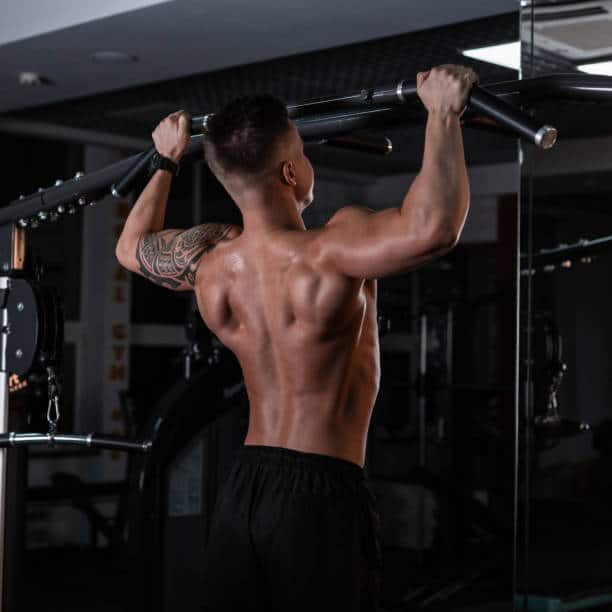
Lat Pulldown Muscles Worked: My Guide & Tips
To boost your upper body strength, focusing on lat pulldown muscles worked is essential. The lat pulldown is a powerhouse exercise for developing a strong, toned upper body. Integrating lat pulldowns into your routine can significantly enhance your workout.
This exercise not only improves posture and strengthens your back but also helps balance muscle development for better overall fitness. I’ll provide you with top tips on targeting the right muscles and making the most of your lat pulldown workouts.
Understanding Lat Pulldown Basics

To effectively target lat pulldown muscles, start by gathering the basic gym equipment you’ll need: a cable pulley machine and a lat pulldown bar. These are standard in most gyms and are crucial for performing this exercise correctly.
Begin by adjusting the seat and thigh pad to ensure you’re securely positioned. Proper setup is essential for maximizing the benefits of the exercise and maintaining safety. Choose a manageable weight, especially if you’re new to lat pulldowns.
Once you’re adjusted, grip the lat pulldown bar with an overhand grip. Sit down and position your thighs under the pad. Maintain a straight back and engage your core to ensure proper form and muscle engagement.
As you pull the bar down towards your chest, concentrate on squeezing your shoulder blades together. Perform the movement slowly and with control to effectively work your upper body while minimizing the risk of injury.
Start with lighter weights and focus on mastering the technique. As you become more proficient, gradually increase the weight. Proper use of gym equipment and correct form are essential for building a strong and toned upper body.
Main Muscles Worked by Lat Pulldown
To develop a powerful, well-defined back, the lat pulldown is essential. Let’s examine the primary muscles involved in this workout.
Latissimus Dorsi
The largest muscle in your back is called the latissimus dorsi, or “lats.” Getting the V-shape that so many desire is essential. Gaining breadth and definition from pulldowns requires activating these muscles.
Biceps
Though the back receives most of the attention, the biceps are just as important. For the pulling movement, biceps exercise is essential. Still, it’s critical to prevent them from taking control.
Rhomboids and Trapezius
The muscles that support stability in your upper back are the rhomboids and trapezius. They ensure that you have strong shoulders and a straight posture. This gives you powerful shoulders and a well-rounded back.
| Muscle Group | Primary Function | Importance |
|---|---|---|
| Latissimus Dorsi | Pulls arms down | The key for back width |
| Biceps | Assists in pulling | Supports arm movement |
| Rhomboids | Retracts scapula | Supports posture |
| Trapezius | Stabilizes shoulders | Enhances upper back strength |
Proper Form and Technique
Gaining the most benefit from lat pulldown exercises requires an understanding of proper exercise form and workout methodology. It reduces your risk of injury and helps you achieve greater results.
Grip Position
During a lat pulldown, the muscles you work depend on how you grip the bar. Your back will widen as a result of using a wide grip on the outer lat muscles. By concentrating on the middle back, a tight grasp promotes muscular growth in regions such as the rhomboids. Select a grip based on your desired muscle focus and training objectives.
Body Position
Sit with your lower back slightly arched. Maintain a raised chest and back shoulders. Hold the bar stationary and move only when necessary. This reduces strain and improves muscular engagement.
Controlled Movements
A good lat pulldown requires deliberate, slow motions. Observe the gradual descent and the steady ascent again. This deliberate movement promotes muscle growth and strength.
| Aspect | Tips for Proper Technique |
|---|---|
| Grip Position | Choose between wide and narrow grip based on targeted muscles. Maintain a consistent grip throughout the exercise to ensure stability. |
| Body Position | Keep a slight arch in the lower back, chest up, and shoulders back. Minimize body movement for maximum muscle engagement. |
| Controlled Movements | Focus on slow, deliberate eccentric and concentric phases. Avoid using momentum to ensure muscle activation. |
Common Mistakes to Avoid

Many people encounter common mistakes during lat pulldowns that can hinder progress and pose risks. Let’s explore these pitfalls and how to correct them to improve your performance and safety.
One major issue is using excessive momentum. Swinging or jerking the bar reduces the exercise’s effectiveness and can lead to injury. Instead, focus on controlled movements. Aim for a slow, deliberate pace to ensure that your muscles, not momentum, are doing the work.
Another frequent error is not controlling the weight during the eccentric phase, which is when you return the bar to the starting position. Lowering the bar too quickly allows gravity to do the work rather than engaging your muscles. Maintain a steady pace throughout the movement to keep tension on your lats and ensure effective muscle activation.
Grip position is also crucial. A grip that’s too wide or too narrow can affect which muscles are targeted. For optimal engagement of the lats, biceps, and rhomboids, adjust your grip to shoulder width.
Posture is another common mistake. Leaning too far back shifts focus away from the lats and can engage incorrect muscles. Keep your torso upright or slightly tilted to ensure you’re properly targeting your lats. Using mirrors or getting feedback from a workout partner can help you maintain the correct posture.
Lastly, not using a full range of motion limits muscle activation. Make sure you pull the bar down to your chest and fully extend your arms on the way up. This complete range of motion maximizes muscle engagement and development.
By addressing these issues, you can significantly improve the effectiveness of your lat pulldown workouts. Remember, focus on controlled movements, proper grip, correct posture, and full range of motion to boost strength and enhance your overall workout efficiency.
Variations of the Lat Pulldown
Changing up your grip for lat pulldowns can significantly alter your workout regimen. These adjustments help you stay out of a slump by adding variation to your workouts.
Wide Grip Lat Pulldown
The latissimus dorsi’s outside regions are the focus of the broad grip lat pulldown. It facilitates improved upper back focus. Pull the bar down to your chest while maintaining a slight arch in your back to do this. For optimal effects, move deliberately and slowly.
Close Grip Lat Pulldown
On the flip side, the close grip lat pulldown targets the lower lats and middle back more intensively. By using a closer grip, you engage more muscle fibers and achieve a fuller range of motion. To perform this variation, sit up straight and grasp the bar with your hands close together. As you pull the bar down to your chest, focus on squeezing your shoulder blades together to maximize muscle engagement.
Reverse Grip Lat Pulldown
The reverse grip lat pulldown, also known as the underhand grip, shifts the focus to your biceps and lower lats. By holding the bar with your palms facing towards you and keeping your elbows close to your sides, you can enhance both arm and back strength. This grip variation not only adds diversity to your workout but also helps target different muscle fibers, contributing to overall muscle development.
Incorporating these grip styles into your routine can significantly improve your back strength and muscle definition. Whether you’re aiming for enhanced muscle tone, increased strength, or simply more variety in your exercises, mastering these techniques will make your lat pulldowns more effective.
Tips for Maximizing Your Lat Pulldown Workouts

Make lat pulldowns a cornerstone of your workout plan to maximize upper body strength and muscle growth. Focus on progressively increasing the weights and consistently training to see notable improvements in muscle size and strength. Additionally, ensure you’re using proper form during lat pulldowns to fully engage the target muscles and prevent injury. Along with lat pulldowns, incorporating lower trap workout tips can help improve posture, stabilize your shoulders, and enhance overall back development. By balancing your training with these techniques, you’ll achieve a stronger, more well-rounded upper body over time.
Begin by gradually adding small increments of weight or increasing the number of reps over time. This progressive overload keeps your muscles continually challenged, fostering growth and strength development. Regularly monitor your progress to fine-tune your routine and ensure you’re on track.
Consistency is key to achieving optimal results. Aim to incorporate lat pulldowns into your routine at least twice a week. This regularity helps maintain muscle strength and prepares your body for greater challenges.
To achieve well-rounded muscle development, diversify your exercises. Complement lat pulldowns with rows and deadlifts to ensure balanced muscle growth. These additional exercises enhance the effectiveness of your lat pulldowns and contribute to overall upper-body strength.
| Strategy | Action | Benefit |
|---|---|---|
| Progressive Overload | Increase weights or reps gradually | Enhanced muscle growth |
| Consistent Training | Regular sessions per week | Steady strength and endurance improvements |
| Exercise Variation | Blend with rows and deadlifts | Balanced muscle development |
You must monitor your development. Track your workouts with an app or journal. You can stay motivated and identify areas for improvement by doing this.
Finally, never underestimate the significance of relaxation and a healthy diet. Your workouts are more successful when you eat healthily and get enough sleep. You may maximize the benefits of your lat pulldown exercises by doing this.
Wrapping Up: Integrating Lat Pulldowns Into Your Routine
As we wrap up this guide, let’s look at how to integrate lat pulldowns into your workout plan effectively. Lat pulldowns should be a key component of your routine, but they’re most effective when combined with other exercises.
Aim to incorporate lat pulldowns into your workouts two to three times per week. This frequency allows for optimal muscle growth and recovery. To ensure a well-rounded approach, pair lat pulldowns with complementary exercises like rows and deadlifts. This combination will help you achieve a balanced back workout and contribute to overall strength and muscle development.
Be mindful of how your body responds to your routine. If you experience excessive fatigue or soreness, it may be time to adjust your workout plan. Incorporating lat pulldowns thoughtfully will lead to a stronger, more defined back and enhance your overall fitness. Stick with your training regimen, and you’ll soon see noticeable improvements in both performance and physique.
FAQ
What muscles does the lat pulldown target?
The lat pulldown primarily targets the latissimus dorsi, the largest muscle in your back. It also engages the biceps, rhomboids, and trapezius muscles. This comprehensive engagement helps enhance upper body strength and balance.
How can I improve my lat pulldown technique?
Enhance your technique by maintaining the correct grip and proper body alignment. To target the upper back and shoulders, use a wide grip, while a narrow grip focuses on the middle back. Ensure you move slowly and with control to engage your muscles fully.
Are there different variations of the lat pulldown?
Yes, several variations, such as wide grip, close grip, and reverse grip lat pulldowns, each target different areas of the back. These variations help enhance muscle definition and can aid in overcoming workout plateaus.
What are some common mistakes to avoid while performing lat pulldowns?
Avoid using excessive momentum, failing to control the weight, and pulling the bar too far. Instead, focus on smooth, controlled movements and stop just below your chin. Begin with a manageable weight to ensure proper form and effectiveness.
How often should I incorporate lat pulldowns into my workout routine?
Aim to perform lat pulldowns 2-3 times a week based on your fitness goals. Balance these sessions with other exercises to ensure comprehensive upper body strength and adequate recovery.
How do I choose the right weight for lat pulldowns?
Start with a weight that allows you to complete 8-12 reps with the correct form. Increase the weight when you can easily perform more reps. Continuously challenge your muscles by gradually adding weight as your strength improves.
Can lat pulldowns help improve posture?
Yes, lat pulldowns improve posture by strengthening the muscles in your upper back. A robust back minimizes slouching and keeps you standing. For optimal effects, concentrate on using your back muscles during the workout.
What is the importance of controlled movements in lat pulldowns?
For efficient muscle engagement and injury avoidance, controlled motions are essential. Move smoothly and methodically during the pulling and lowering phases.
Can beginners perform lat pulldowns?
Yes, even a novice can perform lat pulldowns. To learn the form, start with a modest weight and then increase it as you gain strength and confidence. It’s a fantastic workout for strengthening your upper body.
How can I maximize the effectiveness of my lat pulldown workouts?
For optimal results, progressively increase the weight, maintain a regular workout schedule, and incorporate various grip types. Pay attention to your body’s signals and adhere to a balanced workout plan to ensure comprehensive muscle growth.



